Editor's Note: Won't you join me and the MiceAge/MiceChat staff in
welcoming Steve DeGaetano back to the site, this time as a regular
columnist. His previous guest columns were among the most read and
complimented that we've ever run. As you probably already know his expertise
and passion for the Disneyland Railroad has already made for two wonderful
books, so be sure to visit his site by clicking on the links provided below
to find out more about them. - Al
It's cold and dark at 6am, even at Disneyland. There
aren't too many folks walking around backstage at this hour. Maintenance people
in their dark uniforms move like phantoms under the dim lights. An occasional
cast member whizzes by on a bicycle, a mere shadow on wheels. The moon casts a
pale glow over the area, giving hazy definition to old ride vehicles and parade
floats and the esoterica of a living theme park.
Turning the corner, one is confronted with a large
green-painted industrial building. The structure's windows glow warmly from the
lights within. An illuminated sign attached to the side of the building,
showing a hard-hatted and overall-sporting Mickey Mouse, tells what this
imposing facility is: Roundhouse Facility--Monorail/Steam Trains.
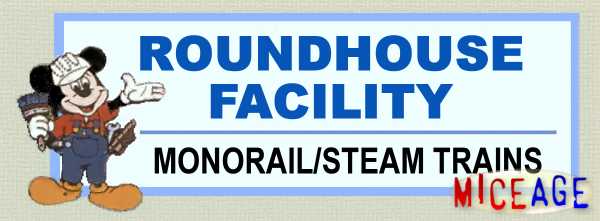
Walking towards the front of the building, one becomes
vaguely aware of strange sounds emanating from within. A hissing, rumbling,
pounding sound. The sound of metal striking metal. The sounds of hammering and
banging. Muffled voices.
Coming around to the font of the building, one is confronted
with an awesome sight. The steely faces of four looming locomotives stand guard
at each of the four open stalls of the roundhouse, peering out resolutely into
the gloom. Their commanding presence causes visitors to speak in hushed,
reverent tones. You are guests here, and the steam locomotives that live here
seem to demand respect.
As light begins to brighten the skies, more and more cast
members arrive. It's the beginning of a new day at Disneyland, and another day
in the life of the Disneyland Railroad. Roaring fires have been built in the
bellies of the ancient steam engines, and steam pressure is building--the
powerful vapor that will propel these conveyances throughout the day, and that
which gives them effusive life. Smoke and steam billow up the smokestacks, and
up through the ceiling vents placed directly above the stacks. The air
compressors thump and pound loudly as cast member polish the paint and brass on
their venerable steeds.
Soon, each engine scheduled to operate today will make its
way out of the roundhouse, where the boiler will be "blown down;" the
time-honored method of blasting boiler-damaging scale and sediment from the
engine's bowels. The sun climbs higher in the sky, and it's nearly time to send
the first train out to the main line.
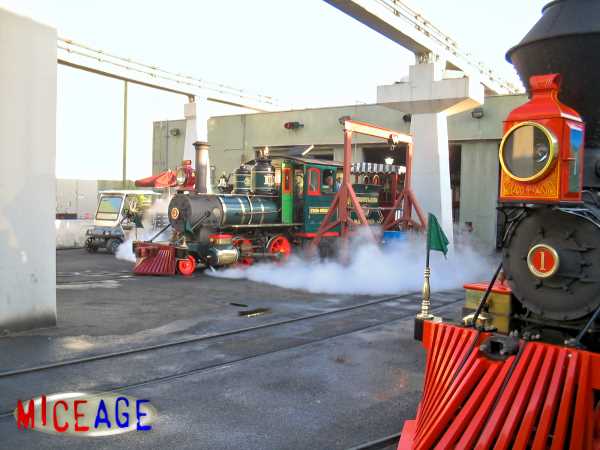
Daybreak on the Disneyland Railroad. Photo
courtesy Preston Nirattisai.
The facility is a veritable beehive of activity now, as
engineers, firemen and conductors arrive to operate Walt's railroad. Polishing
continues to the very end. Engines are coupled to trains; safety chains are
connected, brakes tested. Crews climb into cabs, conductors onto trains. And
then, with two ear-splitting blasts of a whistle, the first train of the
morning creaks and groans and strains against the weight of her eight cars.
Steam and water, mixed with oil, spray the ground and the guttural roar of the
fire increases. "Chuff" is followed by "chuff, " and another, and another, and
slowly the train snakes its way along the yard tracks in front of the
roundhouse, wheels clicking over rail joints, gliding onwards towards the Park.
Soon, the other trains follow, and when the last one vanishes around the bend,
its whistle echoing in the distance, the facility becomes quiet again. Once
more, one hears the occasional sound of metal striking metal. The occasional
sounds of hammering. Muffled voices.
This is the Disneyland Railroad roundhouse, and this is its
story.
It's certainly a legitimate question, so we should answer it right at the
beginning. Why "roundhouse?" Obviously, the Disney facility
isn't round in any sense of the word. Well, it all has to do with history...
Steam locomotives differ from diesel engines in that they
are designed to operate in one direction only--forward. Diesels, on the other
hand, can operate efficiently in either direction, and frequently do. This need
to have steam locomotives properly oriented on the track led to the invention
of the turntable—sort of like a large Lazy Susan with railroad tracks on it.
The steam engine could roll onto the turntable, and be rotated 180 degrees. In
the early days, the rotating was done manually, but later on, air or steam
powered engines powered the turntable.
Back in the glory years of steam railroading, every major
terminal had at least one turntable. But the railroad also needed facilities in
which to repair and store the steam engines of the line. The solution was the
roundhouse.
Fanning off the turntable were the many storage tracks of
the railroad. Roundhouses were round because they were built to follow the
curve of the turntable. Some roundhouses, like the Baltimore & Ohio's 1884
Mount Clare facility below, were built to completely surround and enclose the
turntable, with storage tracks radiating from the turntable in the center.
These were truly "round" houses!
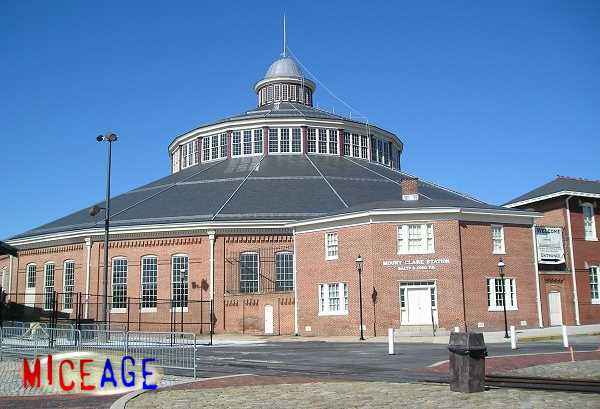
The Baltimore & Ohio roundhouse is now a
railroad museum in Mt. Clare.
Later, roundhouses were built that did not completely
surround the turntable, and were semi-circular in design.
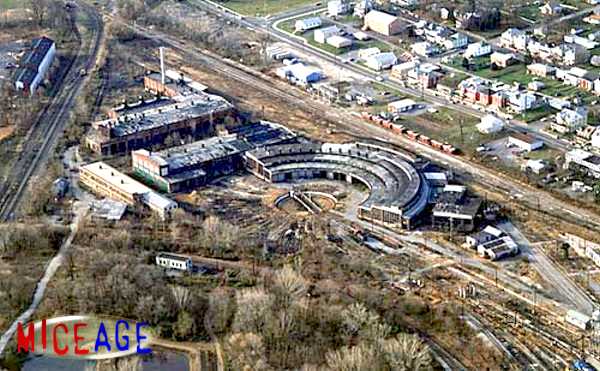
An overhead view of a typical late-steam era
roundhouse and turntable.
Much service and
maintenance occurred in the roundhouse. Here, locomotives were oiled and wiped
down, inspected, minor problems attended to, and often, a steam supply was
connected to the engine to allow the steam pressure in the boiler to remain
without needing to have someone monitor a fire in the engine's firebox. Here
the engines would rest until called upon to once again take to the road with
freight or passengers.
Roundhouses truly were the "stable" of the iron horse.
Railroad photographer and author Don Ball Jr. Had this to say about the steam
locomotive roundhouse:
If you were ever
inside a roundhouse, it was an experience you'll never forget. Inside this
cavernous home, the first thing that struck you was the size of the
locomotives! Close up...right next to you! And the noise! Everywhere you could
hear the banging and pounding of hammers, the chit-chat, chit-chat of
alemite guns, and the ear-splitting hiss of steam. A whistle from a far
stall echoed through the murky air, and the roar from open cylinder cocks
could be heard as an engine backed out onto the turntable. Most of the
engines remained in their stalls for routine inspections, some for boiler
washouts and repairs, other simply awaiting their assignments.
The Disneyland roundhouse is, of course, rectangular, but it
performs virtually all of the same functions that took place in the "real"
railroad roundhouses of a century ago. In railroading, tradition often trumps
reality, and the name of the Disneyland roundhouse reflects that concept. Walt
Disney, you see, had a thing about railroading tradition.
Walt Disney loved trains, and was an avid rail fan. As has
been documented many times, Walt's passion for trains served as a sort of
catalyst in congealing his ideas about family entertainment in an outdoor
environment into a place he called "Disneyland." Walt was so enamored
of trains that even the very first concept drawings of the little park that he
envisioned, existing on a sliver of land across from his studios in Burbank,
California, featured trains.
Those early drawings, however, lacked one thing every steam
railroad required: Some sort of service facility. It was at least three
drawings removed from the original plan that we first see a roundhouse to care
for the trains. It was a typical semi-circular design surrounding a turntable,
with a rectangular adjoining shed to store the cars. Later, when Marvin Davis
drew the first drawing to include the Hub, the roundhouse and turntable were
kept.
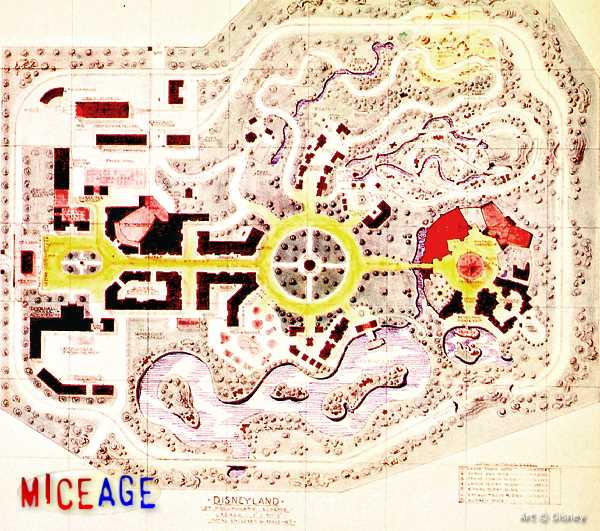
The semi-circular roundhouse can be seen in the
upper left corner of this Marvin Davis drawing.
|


